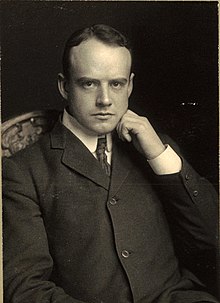David Moore Robinson | |
|---|---|
 Robinson in 1909 | |
| Born | September 21, 1880 |
| Died | January 2, 1958 (aged 77) |
| Occupation | Classical archaeologist |
| Years active | 1904-1958 |
| Known for | Excavations at Olynthus |
| Spouse | Helen Haskell |
David Moore Robinson (September 21, 1880, in Auburn, New York – January 2, 1958, in Oxford, Mississippi) was an American classical archaeologist credited with the discovery of the ancient city of Olynthus. [1] [2] While he was a prolific writer and advisor, he also has gained notoriety due to his plagiarism of his students, the most notable being Mary Ross Ellingson. [3]
Biography
Robinson earned his A.B. (1898) and Ph.D. (1904) at the University of Chicago. Robinson served on the faculty of Johns Hopkins University (1905-1947). [4] After his retirement, which also marked a falling out with Johns Hopkins, he moved to the Department of Classics at the University of Mississippi in Oxford, Mississippi. [5] [6] Many ancient objects from Robinson's collection were donated to the University of Mississippi and now constitute the David M. Robinson Memorial Collection of Greek and Roman Antiquities. [7] His collection of papyri and manuscripts were given in his will to colleague William Hailey Willis. [8]
In addition to the excavations at Olynthus, he participated in archaeological excavations at ancient Corinth (1902) and Sardis (1910), as well as Pisidian Antioch (1924).
Among his students (he is credited with training 75 Ph.D. recipients and 41 M.A. recipients) were George M.A. Hanfmann, Eunice B. Stebbins [9] Allan Chester Johnson, George E. Mylonas, Paul Augustus Clement, Jr., [10] James Walter Graham, Mary Ross Ellingson, Helen Henrietta Tanzer, and William Andrew McDonald. [11]
Robinson was elected to the American Academy of Arts and Sciences in 1934 and the American Philosophical Society in 1936. [12] [13] He was awarded the Cross of the Royal Order of the Phoenix by King Paul of Greece in 1957. [14]
Plagiarism
Robinson published his findings at Olynthus in a 14-volume series, Excavations at Olynthus, most of which he wrote himself. However, it has since been proved that he plagiarized the work of his student Mary Ross Ellingson, and he has been accused of plagiarizing at least three other students as well. It has been shown that he published Ellingson's master's thesis and doctoral dissertation in volumes VII and XIV of Excavations at Olynthus as his own work. [3] [15]
Publications
- 1904. Ancient Sinopea. University of Chicago (dissertation). [16]
- 1924. Sappho & Her Influence on Ancient and Modern Literature [17]
- 1930. with C. G. Harcum and J. H. Iliffe. A Catalogue of the Greek Vases in the Royal Ontario Museum of Archaeology, Toronto. Toronto: The University of Toronto Press.
- 1929-1952. David M Robinson; George E Mylonas. Excavations at Olynthus. (Johns Hopkins University studies in archaeology, no. 6, 9, 11-12, 18-20, 25-26, 31-32, 36, 38-39.) 14 v. Baltimore: Johns Hopkins University Press.
- 1934-1938. with S. E. Freeman and M. McGehee. The Robinson Collection, Baltimore, Md.( Corpus Vasorum Antiquorum. United States of America fasc. 4, 6-7.) Cambridge, MA: Harvard University Press.
- 1951-1953. George E. Mylonas; David M. Robinson; Doris Raymond. Studies presented to David Moore Robinson on his seventieth birthday. 2 v. Saint Louis: Washington University.
References
- ^ "Robinson, David Moore." Encyclopedia of the History of Classical Archaeology. Nancy Thomson de Grummond, ed. Westport, CT: Greenwood Press, 1996, vol. 2, pp. 963-64.
- ^ * George E. Mylonas: Necrology in College Art Journal 18.1 (Autumn, 1958), p. 76.
- ^ a b Kaiser, Alan. Archaeology, Sexism, and Scandal: The Long-Suppressed Story of One Woman's Discoveries and the Man Who Stole Credit for Them. New York; London: Rowman & Littlefield, 2014.
- ^ University of Chicago (1915). The University Record. University of Chicago Press. pp. 129–.
- ^ Hutton, Jeremy M. (2017-06-12). "Archaeology, Sexism, and Scandal: The Long-Suppressed Story of One Woman's Discoveries and the Man Who Stole Credit for Them by Alan Kaiser (review)". Journal of Eastern Mediterranean Archaeology and Heritage Studies. 5 (2): 247–250. doi: 10.5325/jeasmedarcherstu.5.2.0247. ISSN 2166-3556.
- ^ Leslie, Bill. "History of David M. Robinson and Classics at Johns Hopkins" (PDF). JOHNS HOPKINS UNIVERSITY ORAL HISTORY PROGRAM. Retrieved 28 April 2020.
- ^ "David M. Robinson Memorial Collection of Greek and Roman Antiquities".
- ^ Will of David Moore Robinson, Lafayette County Chancery Clerk’s office, recorded in Book 4, Page 399.
- ^ Robinson, David M. (1929). "A Preliminary Report on the Excavations at Olynthos". American Journal of Archaeology. 33 (1): 53–76. doi: 10.2307/497648. ISSN 0002-9114. JSTOR 497648. S2CID 193121038.
- ^ Paul Augustus Clement Jr. (1906-1986) was a member of the Department of Classics at UCLA from July 1, 1949 until 1973. http://texts.cdlib.org/view?docId=hb6z09p0jh&doc.view=frames&chunk.id=div00013&toc.depth=1&toc.id=
- ^ David Moore Robinson (1953). Studies Presented to David Moore Robinson On His Seventieth Birthday. Washington Univ.
- ^ "David Moore Robinson". American Academy of Arts & Sciences. 2023-02-09. Retrieved 2023-06-02.
- ^ "APS Member History". search.amphilsoc.org. Retrieved 2023-06-02.
- ^ "BIOGRAPHICAL SKETCH OF DAVID MOORE ROBINSON" https://classics.olemiss.edu/wp-content/uploads/sites/159/2011/01/Robinson_biography.pdf
- ^ Gaca, Kathy L. "Alan Kaiser, Archaeology, Sexism, and Scandal: The Long-Suppressed Story of One Woman's Discoveries and the Man Who Stole Credit for Them." (Book review). Bryn Mawr Classical Review, Feb. 3, 2015.
- ^ Internet Archive: University of Toronto - Robarts Library > Ancient Sinope : a dissertation https://archive.org/details/ancientsinopedis00robiuoft
- ^ Henry Rushton Fairclough (1927). The Classics and Our Twentieth-century Poets. Stanford University Press. pp. 32–. GGKEY:1JYBQXG8WZB.
External links
- David Moore Robinson at the Database of Classical Scholars
- Dictionary of Art Historians: Robinson, David Moore Archived 2016-03-04 at the Wayback Machine
- Works by or about David Moore Robinson at Internet Archive
- "The Long-Suppressed Story of One Woman’s Discoveries & the Man Who Stole Credit for Them", Indiana Historical Bureau